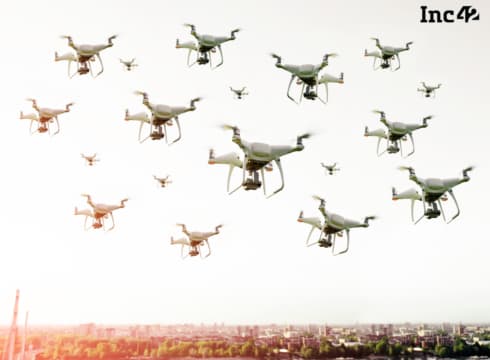The global market for commercial use of drones is valued at over $127 Bn
India’s drone policy 2.0 which should boost commercial drone applications is far from ready
The current policy’s line-of-sight rule makes scaled-up commercial use of drones next to impossible
Inc42 Daily Brief
Stay Ahead With Daily News & Analysis on India’s Tech & Startup Economy
When the Indian Premier League talks about drones, you know they have entered the mainstream. Despite the increasing popularity of drones used for films, live sports and videos, there is a lot of room for growth and the dearth of drone applications in India is a worrying sign for anyone who has roots in this industry.
“Our Superstar – The Drone Cam” — Former New Zealand cricketer Danny Morrison during an IPL 2018 match.
One of the primary reasons for this lack of innovation and groundbreaking work in drones in India is the lack of government support. For example, in October 2014, the Directorate General of Civil Aviation (DGCA) in India imposed a blanket ban on drones after flags were raised by the Mumbai police over a single instance of drones for deliveries. Mumbai-based Francesco’s Pizzeria used a four-rotor drone to deliver food over a short distance in the city, but that attracted the attention of law enforcement, and the significant buzz for the pizza outlet also resulted in the government scrutinising the use of drones in India.
Around the same time, several drone startups had begun operating in the Indian market as well, looking forward to the opportunity it offered. However, the status of their work was murky as the government had not given legal clearance to many of these startups. All that changed last year, when the government released the regulatory Drone Policy 1.0, which came into effect in December 2018.
The drone policy is primarily meant to facilitate the commercial usage of drones, lay down the operational rules for drones, and to provide checks and balances for companies involved in drone applications. It should have been just what the industry wanted. But it lacked the depth that startups needed to scale up their drone operations, given the massive opportunity.
In the last few years, consumer interest in drones has scaled up with rising demand for aerial photography, and a wide range of commercial applications in India’s B2B sector. According to a new study by PwC on the commercial applications of drone technology, the global market for business services using drones is valued at over $127 Bn, but India has been slow to tap into that market, despite the drone policy.
To be fair, the new drone policy stirred excitement about the opportunities it could bring for startups. Drones can help reduce human errors in sectors such as aviation and can be used for commercial delivery and logistics in a more effective way. They can also be used to gather precise spatial data, the lack of which has hampered development in India’s agriculture, manufacturing, construction and planning sectors.
One of the major criticisms of the drone policy, however, is that it lacks a precise framework and a robust setup to reduce misuse or scale up operations. While the new drone policy establishes an intricate system of approval for applications and procedures, it is lacking when it comes to monitoring of drones. It also ignores the implications of free movement of smaller drones, which have been exempted from many of the regulatory procedures.
The policy 1.0 is still not up to the mark in terms of facilitating a sustainable environment for commercial applications of drones, as it bars the operation of drones when they leave the human line of sight. This makes it impossible for the companies to use drones for their scaled-up operations such as hyperlocal deliveries, which is a big opportunity lost for Indian drone startups.
Further, there is no way for the government to monitor the usage of drones, which would result in controlled tests and experiments. This created a grey area for drones flying below the 15-metre mark and has also resulted in an uncharted and unregulated space which poses security and physical threats pose a huge security threat.
One example is the incident on August 20, 2017, when operations at the Indira Gandhi International Airport in Delhi were suspended for about 40 minutes after a pilot spotted a drone in the airspace above the runways. A similar disruption due to drones occurred in July 2018, and again on August 2018. This means even despite a drone policy, Indian regulators are unable to monitor the activity of each and every drone which is launched by users or startups.
India’s new drone policy definitely needs a stricter framework and monitoring mechanisms to make sure that the usage of drones is not illegal and does not hamper the legal efforts of drone startups. It also needs more robust features to approve applications in a swifter way, renew drone flying permits without too much red tape, and allow operations of drones beyond the line-of-sight limit.
Finally, the policy needs to bring in a better redressal system for grievances from drone startups or to collect feedback from these startups to create the ideal market conditions for the sector to succeed in India. Given the sheer breadth of applications and the immense addressable market size, it would be a huge opportunity loss for drone startups in India, if the government’s drone regulations continue to leave out essential growth factors.
DOWNLOAD THE FREE REPORT{{#name}}{{name}}{{/name}}{{^name}}-{{/name}}
{{#description}}{{description}}...{{/description}}{{^description}}-{{/description}}
Note: We at Inc42 take our ethics very seriously. More information about it can be found here.


